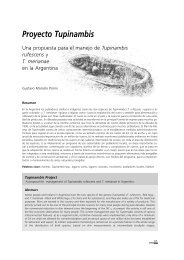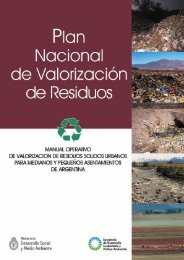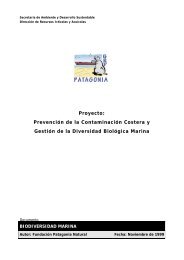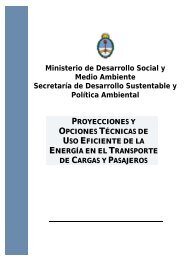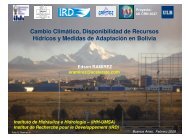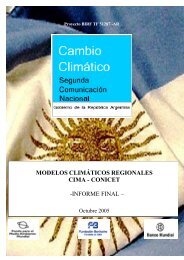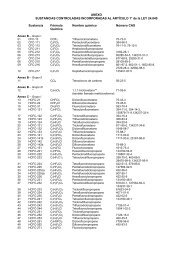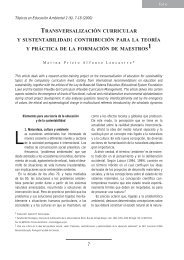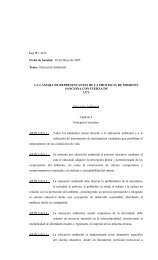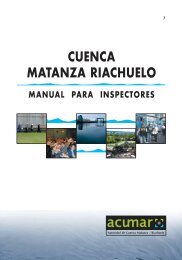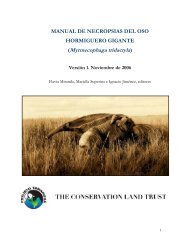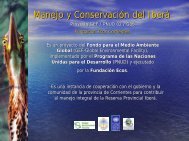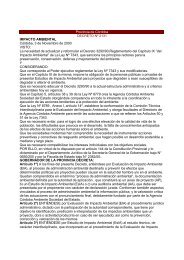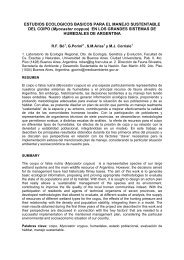Coypu Project - Secretaria de Ambiente y Desarrollo Sustentable
Coypu Project - Secretaria de Ambiente y Desarrollo Sustentable
Coypu Project - Secretaria de Ambiente y Desarrollo Sustentable
You also want an ePaper? Increase the reach of your titles
YUMPU automatically turns print PDFs into web optimized ePapers that Google loves.
<strong>de</strong>fined as the number of animals in relation tothe number of traps placed; “efficacy” as thenumber of traps with <strong>de</strong>vices “triggered” bythe entry of coypus over the total number oftraps triggered, and “selectivity” as thenumber of coypus (“target” animal) capturedin relation to the total number of other animalscaptured by the traps. The preference of thecoypus for different types of baits (potatoes,carrots and cabbages) was also evaluated.The results were satisfactory, since the 98%of the individuals captured by means of thetraps mentioned did not suffer any type ofwounds. The efficacy of the traps was 93%and the selectivity 97%. On the other hand,though the efficiency of capture was relativelylow (20%), it turned out to be higher than thatobtained by other authors (Doncaster andMicol, 1989; Guichón, 2003). No significantdifferences were found among the differenttypes of baits used. However, the use ofcarrots is recommen<strong>de</strong>d due to its greateracceptability in comparison to potatoes andthe relative low cost compared to cabbages(Corriale, 2004).Chemical immobilization of specimens wasevaluated according to the effects of variousdrug combinations in different concentrationsfor sedative and anesthetics effects (Corriale,2004). For sedation purposes, the advisabledose of ketamine hydrochlorate and ofacepromazine maleate was 0.96 mg/kg and0.048 mg/kg, respectively. For eventuallyanesthetizing the animals, the dose was ofketamine hydrochlorate and of xilazinehydrochlorate was 4 mg/kg and 0.5 mg/kg,respectively. The latter dose was similar tothat suggested by Bó et al. (1994) and itwould be the most advisable one since itallows an a<strong>de</strong>quate manipulation of thespecimen (Figure 3), without substantiallyaltering any physiological parameter andassuring an a<strong>de</strong>quate and relatively fastrecovery (Corriale, 2004).To estimate the age of the specimens, variousmethodologies were assessed based on theanalysis of: drained weight of the crystalline,length of the foot, length of the tail (Paschal ofVaccari, 2002), weight (Norris, 1967; Crisp,1974) and total length of the specimens(Colantoni, 1993). Other two methodologieswere proposed based on the measurement ofdifferent skull morphometric features and onthe eruption of the teeth on the gular series(Nazar Anchorena, 2004). A closeexamination of the different proposedmethodologies showed that even if themethod based on the drained weight of thecrystalline seems to be more precise (Paschalof Vaccari, 2002), those that aim atestablishing the corporal weight and themeasurement of three morphometric skullfeatures (basal length, total skull length andtotal jaw length) would be the most advisabledue to their relatively high precision, simplicityand easy implementation in field-researchconditions (Nazar Anchorena, 2004; Corriale,2004). The morphometric skull features wouldalso constitute a useful tool to further evaluatethe effects caused on the exploitedpopulations by studying the ossuaries that areusually found in the camps used by coypusmenonce the hunting season is over.Finally, different methodologies were<strong>de</strong>veloped for the indirect estimations ofpopulation <strong>de</strong>nsity of M. coypus. One ofthem is the method advanced by the relativedisposition of signs –MDRS– (Bó, 1996). It isespecially appropriate for the “marshy-lands”type of environment. This method is based onthe analysis of the structural characteristicsand the relative spatial disposition of threetypes of coypu-presence signs: nests, feedingareas and paths. In the case of stream and/orlagoon environments with high-slopedmargins or edges, three other methods wereput into practice. These were based on theanalysis of the size and the relativedisposition of the un<strong>de</strong>rground entrances ofthe caves (MASC), the feces and/or bothtypes of signs (Corriale, 2004). In all cases,these methodologies were analyzed in fieldconditions and their precision was evaluatedby means of comparing their results withthose through a direct method that implied theexecution of captures with removal, based onthe probability of capture (MCR) (Zippin,1958). The results obtained in relation to theMDRS would indicate that this has a relativelyhigh precision compared to the MCR (r = 0.77,p



